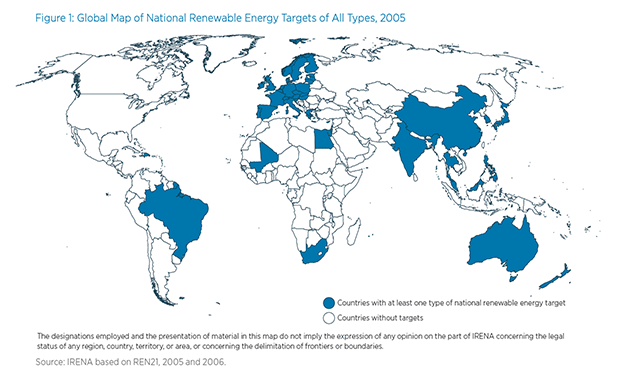Renewable energy targets are now a defining feature of the global energy landscape, according to a new report by the International Renewable Energy Agency (IRENA). Renewable Energy Target Setting, launched on the side lines of IRENA’s ninth Council meeting, finds that 164 countries have adopted at least one type of renewable energy target, up from just 43 countries in 2005. Two more countries, Canada and the United Arab Emirates, have set renewable energy targets at the sub-national level.
“Renewable energy targets have emerged as a popular mechanism to set national and regional economies on the path towards a more secure and sustainable energy future,” said IRENA Director-General Adnan Z. Amin. “They provide an important signal to the industry and can help to align stakeholders by creating a clearer, common vision for the development of the energy sector.”
Developing and emerging economies are leading the adoption of targets, accounting for 131 of the 164 countries with renewable energy targets. The majority of countries focus on the electricity sector – 150 countries have renewable electricity targets – but commitments in other sectors are also on the rise. The number of countries setting targets for the heating/cooling sector increased from two countries in 2005 to 47 today. Similarly, renewable transport targets have more than doubled from 27 countries in 2005 to 59 today.
“Governments are increasingly adopting renewable energy targets to meet multiple objectives including energy security, environmental sustainability and socio-economic benefits,” said Mr. Amin. “The rapid growth of targets is just one more signal of the world’s ongoing shift towards renewable energy and away from fossible fuels.”
While underscoring the importance of renewable energy targets, the report recognises that they are not sufficient in and of themselves. In order to be seen as credible by investors and society and to provide a reliable trajectory for the future evolution of the energy mix, they need to be accompanied by a clear strategy and backed by specific policies and measures.
What are renewable energy targets? Why set a renewable energy target? How should they be designed and translated into specific policy instruments?
Renewable energy targets have become a defining feature of the global energy landscape. Some 164 countries around the world have adopted at least one type of renewable energy target as of mid-2015, up almost four-fold from 43 countries in 2005. Developing and emerging economies took on a leading role during the decade, accounting for 131 of the 164 with targets in place.
Renewable energy targets can take a wide range of forms and are often embedded into integrated sector-level resource plans, national renewable energy action plans, or broader national development plans. Renewable Energy Target Setting presents a global overview of the diversity of renewable energy targets and brings together insights from a wide range of countries from a policy-design perspective.
The report, produced by the International Renewable Energy Agency (IRENA), highlights the critical importance of definitions and specific design features suited to different objectives. It lays out a comprehensive framework, which can inform policy makers as they embark on the task of designing – or revising – their respective national or local renewable energy targets.
The International Renewable Energy Agency (IRENA) is mandated as the global hub for renewable energy cooperation and information exchange by 140 Members (139 States and the European Union). Roughly 32 additional countries are in the accession process and actively engaged. IRENA promotes the widespread adoption and sustainable use of all forms of renewable energy, including bioenergy, geothermal, hydropower, ocean, solar and wind energy in the pursuit of sustainable development, energy access, energy security and low-carbon economic growth and prosperity.
http://www.irena.org/DocumentDownloads/Publications/IRENA_RE_Target_Setting_2015.pdf




